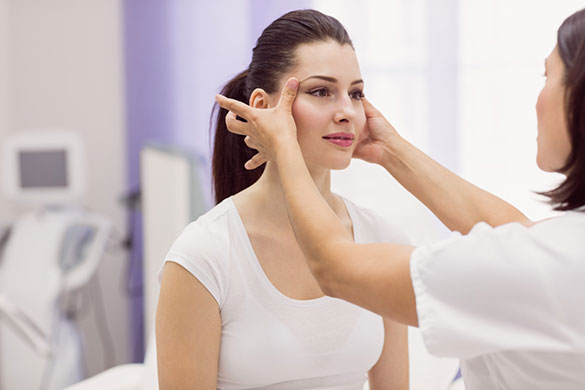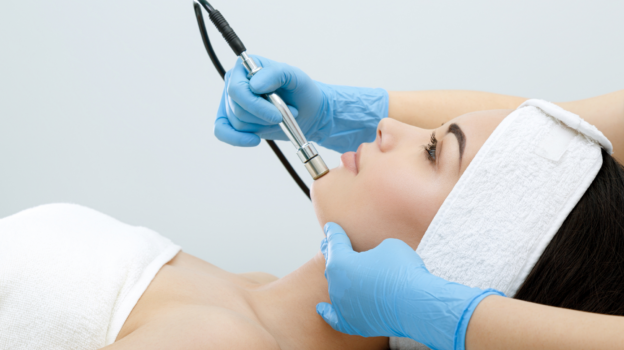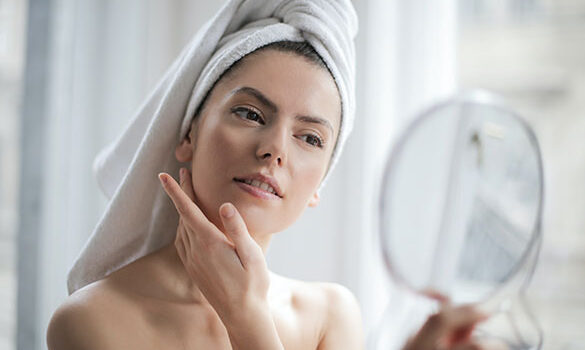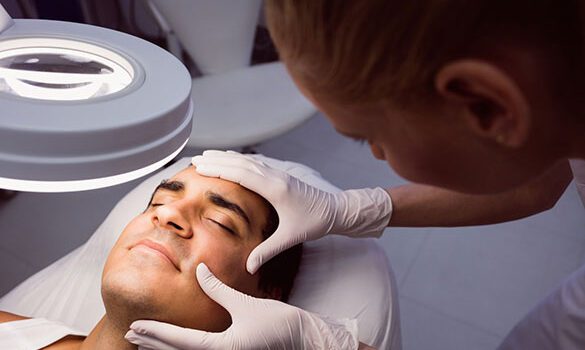A chemical peel is a treatment that aims to improve and smoothen the skin’s texture. The procedure uses a chemical solution to remove the top layers of the skin to allow healthier skin to grow back. Although a chemical peel can be used on the face, neck, and hands, it is most commonly applied on the face.
Chemical peels reduce premature signs of aging, acne, hyperpigmentation, discoloration, melasma and more. There are many reasons to opt for a chemical peel, but before you do so, it is important to choose a reputable clinic for your chemical peel in Toronto, and understand the before, during, and after processes of it.
As a result of these many benefits. this minimally invasive cosmetic surgery has seen significant growth in popularity over the last few years. But, due to the complexity as well as risks of performing a chemical peel, Health Canada recommends visiting professionals for the treatment.
At GraceMed, we offer chemical peel treatments at our medical clinics in Mississauga, North York, Oakville, and Burlington offer this treatment. You can book a consultation with us today and we will help walk you through your options and answer any of your questions.
Before your consultation, you can use this guide to better understand what to expect from your chemical peel before and after treatment:
Before Chemical Peel
Although a chemical peel is non-invasive and non-surgical, it is essential to properly prepare for the treatment procedure to achieve the best results. It can feel scary to head into the treatment without adequate knowledge, so this guide can help you better understand the steps you need to take to be prepared for treatment.
Determine If You’re an Ideal Candidate
The first thing you need to determine before your chemical peel is whether you are a good candidate for the treatment. You may need to do some extensive research to determine whether chemical peels are an ideal choice for you based on your skin type and complexion.
Chemical peels can be beneficial for many skin types, but they can also have adverse effects on others. Discuss any skin conditions you have during your consultation to avoid complications during the procedure.
Consult A Professional
After you do some research to help determine if you’re a suitable candidate, speak to a skin specialist before your chemical peel appointment. A specialist will review your medical history and answer any questions regarding the treatment.
You may also be asked to participate in a physical exam to determine what type of peel will best suit your skin. This will be an excellent opportunity to learn about the potential risks of the treatment and understand what happens before and after.


Learn About the Risks
Although chemical peels are relatively safe, many cosmetic treatments have side effects. The first step to avoiding long-term risks is deciding whether the treatment is suitable for your skin and lifestyle.
To be fully prepared for the procedure, be aware of the side effects that you could encounter, such as redness, scabbing, swelling, scarring, changes in skin color, and infection. Since there are different chemical peels you can choose from, it is essential to determine the kind of treatment that would best help your skin and have the lowest risks.
Take Antiviral Medication
Many patients are prescribed antiviral medication before and after a chemical peel to prevent a viral infection due to treatment. You will most likely need to take the antiviral medication or antibiotics 24 hours before your chemical peel and for a short time after the treatment.
The specialist performing the chemical peel will provide you with specific instructions on how to take care of your skin before and after the treatment.
Avoid Sun Exposure
Excessive sun exposure before the procedure can cause complications during your chemical peel. Going under direct sunlight without protection can cause permanent irregular pigmentation and side effects during the chemical peel.
Most chemical peels work better on skin that isn’t sun-damaged, so it is best to avoid the sun for a few weeks before your treatment to achieve the best results. If you do have to go under the sun, choose the best sunscreen for your skin and wear a wide-brimmed hat to reduce skin exposure.
Create a List of Medications to Avoid
Some medications that you use regularly can interact with the acids used in chemical peels and result in side effects or complications before and after a chemical peel. You may need to stop taking certain medications for a specific time before your treatment. Some medications could include contraceptives, tranquillizers, NSAID Pain relievers, aspirin, and herbal supplements.
Discuss your medication list with the skin specialist to determine which medication you can continue taking and which ones to avoid.


Discuss Your Expectations
As we see an increase in demand for medical aesthetics services, many skin treatments, such as chemical peels, continue to improve with the help of technology and specialists. However, it is essential to prepare yourself before undergoing any treatment.
You must set realistic expectations from a chemical peel before and after treatment. Before your treatment, discuss your skin goals during the consultation to avoid disappointments in the future. You also need to understand the recovery process and the time required to see results.
Going into the procedure without adequate knowledge about the results can lead to unnecessary problems and disappointments after treatment.
During Chemical Peel
Although your skin is in the expert’s hands during the procedure, it can be beneficial for you to know what happens during a chemical peel. Being aware of the steps can relieve any anxiety or stress you feel about the procedure and help you relax.
The exact steps for the peel depend on whether you’re receiving a superficial, medium, or deep peel, but here are the general steps for the procedure.
Step 1: Skin Preparation
Your skin will be cleaned before the chemical peel treatment to ensure there is no dirt on your skin, and the solution can be applied easily. While your skin is being prepared, your hair, eyes, and ears will be protected. You may receive a sedative or painkiller before a medium or deep peel.
Step 2: Solution Application
The chemical solution containing glycolic acid or salicylic acid will be applied to your skin with a brush, cotton ball, or gauze. The solution will be on your skin for a specific amount of time. You may experience some stinging sensation during the solution application.
You may also consider getting a chemical peel that is a professional exfoliation to enhance your skin further. You can enjoy the benefits of exfoliating as many chemical peels use specific AHAs or BHAs to restore skin’s radiance.
Step 3: Remove Solution
A neutralizing solution may be applied to remove the chemical solution from the treated skin, or the solution might be washed off with water.


Step 4: Cool Compress Application
Since your skin will be sensitive after the treatment, you might receive a cold compress on your face to soothe the skin and relief any discomfort. If you had a medium or deep peel, you might be prescribed pain medication to take for a specific period.
After Chemical Peel
The after of your treatment depends on the type of chemical peel you received. Following a consistent aftercare routine is the best way to stay comfortable and achieve the best results from the chemical peel.
Be mindful of the products you apply to your skin after treatment, and don’t undermine the importance of medical grade skincare after a chemical peel. Medical grade skincare is clinically proven to improve skin conditions by using high-quality ingredients.
GraceMed clinics offer medical grade skincare across the GTA that can improve your skin after treatment and address other skin conditions. Refrain from using over-the-counter products after the chemical peel to enhance your skin.
Here is a general timeline to help you prepare for what may occur during your recovery process after the treatment:
Day After
You may experience some redness, burning or tingling during the first few hours after treatment, leading up to the day after. Your skin may also seem unusually dry the next day. Avoid using makeup and stay away from the sun for a few days or until your skin fully recovers.
One Week After
Your skin may start to flake during your first week after a chemical peel. You may also notice some discoloration on your skin. It is essential not to pick or peel the skin and let the peel do its job. Moisturize your skin as necessary, but try not to overdo it, or else the peel may not be as effective.
Two Weeks After
Most of the side effects and healing from a chemical peel are likely to occur within the first two weeks of the treatment, especially if you got a superficial or light peel. Your skin will be flakier at this point, and you can gently remove the flakes when you clean your face but do not pull, pick, or scratch your skin. Scratching or picking the skin can irritate and lead to complications during the healing process.


Month After
Continue taking care of your skin with medical grade skincare until you witness the complete results of the chemical peel. Your skin is likely to stop peeling and appear healthy and smooth at this point. If you got a deep peel, it may take up to a month for your skin to fully recover.
Skin Conditions Before & After Chemical Peel
Although a chemical peel has general benefits for your skin, it can be particularly beneficial for specific skin conditions. Here are some skin conditions that may approve from chemical peel before and after treatment.
Hyperpigmentation
Before a chemical peel, you might be dealing with numerous skin conditions, such as hyperpigmentation. Hyperpigmentation occurs when patches of the skin become darker than the surrounding skin. Although it is harmless, many may find the discoloration unappealing.
A chemical peel will reform the skin and remove the discoloration, leading to healthier, balanced skin. You can also try laser skin treatment offered at some of GraceMed’s clinics, as we offer a few types of treatments that target hyperpigmentation and other skin issues. Talk to our specialists to better understand how you can benefit from chemical peel for hyperpigmentation before and after treatment.
Melasma
Melasma is a skin condition that contributes to brown or blue-gray patches or freckle-like spots. It occurs due to the overproduction of cells that make your skin colour. The condition is often called the “mask of pregnancy,” as many mothers develop melasma or chloasma during pregnancy.
Although melasma is harmless and very common, you can receive treatment to reduce its appearance. A chemical peel can reduce the appearance of melasma as the solution removes the outer layer of the skin that is discolored.
Acne
If you have mild to moderate acne, a chemical peel can penetrate the outer layer of the skin and shed the outer layer with acne. Most chemical peel solutions also contain ingredients that decrease oil secretion and clogged pores.
If you’re looking for acne treatment in Toronto, consult our skin experts at GraceMed to find a chemical peel that can solve your skin concerns. Understanding the benefits of a chemical peel for acne before and after treatment will allow you to make an informed decision about whether the procedure is suitable for you.


Wrinkles
Although wrinkles are a normal part of aging, sometimes they can occur sooner than expected. If you notice premature signs of aging, a chemical peel or MicroLaserPeel® might be a great solution for the condition. Both treatments effectively treat wrinkles to remove the top layer of damaged skin and reveal a fresh layer of healthy skin.
Our experts can guide you through many advantages of getting a chemical peel for wrinkles before and after the procedure.
Getting a Chemical Peel at GraceMed
Every step in the chemical peel process is essential for preparation and recovery. When you have sufficient knowledge about what to do before and after a chemical peel, it will be easier for you to determine if you’re ready for the treatment.
Our team at GraceMed is ready to guide you through the process and help you better understand the benefits of a chemical peel. Book your consultation today to get started on your skin healing process!










